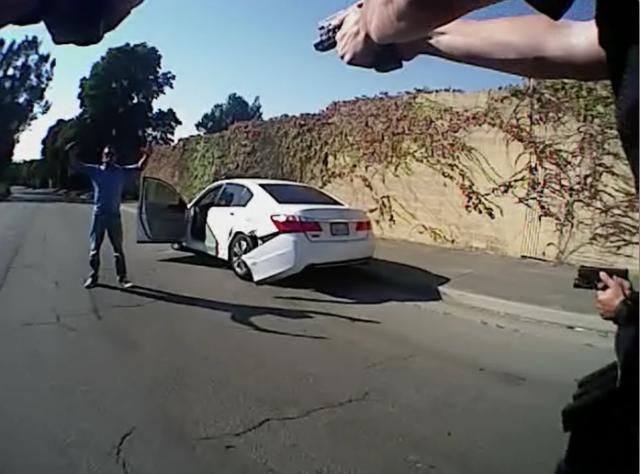
The video shows the tail-end of the August 2017 police chase involving 45-year-old Benicia resident Jeffrey Barboa, who police say was wanted in connection with an armed robbery in El Cerrito. Barboa is seen exiting his car carrying a large knife and slowly walking toward officers, who have their guns drawn and are yelling commands. The footage ends just before the first shots are fired.
Police identified Officers Stephanie McDonough, Jake Estrada, David McLaughlin, Zach Jacobsen and Matt Komoda as having fired at Barboa. In March, the Contra Costa County coroner held an inquest hearing on Barboa’s death, where a jury ruled 8-4 that Barboa’s death was a suicide.
Two officers testified at the inquest hearing that Barboa was screaming, “Kill me,” as he walked toward police.
“It’s a difficult and tragic event all around,” said Vallejo police Capt. Lee Horton. “We agree with the findings of the coroner’s inquest that it was suicide via gunshot.”
Contra Costa is one of a handful of California counties to conduct coroner’s inquest hearings to review in-custody and deaths involving officers. During the hearings, which are held in open court, a jury is asked to choose four manners of death: suicide, accident, natural causes or at the hands of another, not by accident. The rulings carry no civil nor criminal liability, and the hearings are held to give the public a chance to learn the facts of fatalities where officers are involved. Police-release-body-cam-footage-in-fatal-I-80-officer-involved-shooting.
This article is about the coroner’s inquest and not the justification for the shooting. Given the choices and the circumstances, I might have opted for “Natural Causes.” Wave a knife at five cops in the middle of committing a felony while shouting, “Kill me!” What follows seems to be a natural progression, to me.
The officers did come in for some criticism for shooting Barboa 41 times. Five officers into 41 equal eight. That’s the hits, we don’t know how many shots were actually fired. That averages to five hits per officer. The officers seemed to be armed with Sig Sauer semi-automatics, depending on the model has a twelve to fifteen round capacity. Could they have done it with fewer? Certainly. On the other hand, assuming fifteen round magazines, they could have fired a total of seventy-five rounds before reloading and then repeated two more times with spare magazines
The video of the actual shooting is not shown. Had it been, it would have been a simple matter to put a stopwatch on the time from first to last round. It is so simple even a Public Information Officer (PIO) could do it. What would that tell the readers? If FBI statistics on police shootings, going back forty-five years, are any indication, this shooting from first to last round lasted 2.5 seconds.
There would have been no shame had two or three of the officers decided not to shoot. Who decides which officer stands down and which shoots? One valid criticism, that also illustrates my point, is that all of the officers were giving commands which is an indication that none had a leadership role (real or imagined). How to coordinate without somebody taking charge?
As an aside, forty years ago a crook complained to me at the booking desk about this same issue. He complained, “Sarge, you need to tell those assholes on midnights to get their shit together. One of them yells freeze, another yells to get out of the car, and the third tells me to put my hands up. I knew right then and there I was gonna piss two of them off!”
He had a point and I listened. As an investigator, trainer, and supervisor for a narcotics task force we designated one person to give commands and direct movement. Individual team members were given specific assignments. If the team worked as intended, then all contingencies were addressed and what remained was the successful execution of the plan. We had plenty of successful operations, successful plans; nope, the plan went to shit first rattle out of the box.
Could the officers have done something else? Yes, but they didn’t. What they did do was within the law, policy, and training that is the standard that they had to meet. All Barboa had to do was obey the law and in that he failed miserably.
There is a commentary on the phrase,” To take the king’s shilling.” (Enlist in the British army). The observation is that having taken the King’s shilling, (food, clothing, shelter and continuing pay under peaceful circumstances), a soldier couldn’t very well refuse to perform when called upon, during battle. So what? The Sheriff or Police Chief offered these officers a salary, nifty uniform, equipment and car to go out and answer calls. It didn’t matter how many calls they answered or the type, they just had to be there when the time came. The officers accepted the pay and benefits and agreed to answer any calls that came along. Refusing to answer a call because it is dangerous, dirty, or unpleasant is not part of the contract. These five officers answered the call and stood firm. They did what they were paid to do and thus kept the faith with the agency, the community, and each other.
Could they have done things differently? Certainly. Did they violate policy, the law, and acceptable practices? No.